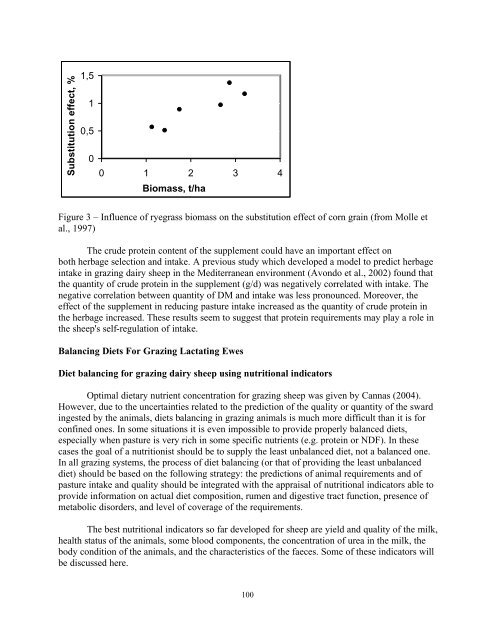Great Lakes Dairy Sheep Symposium - the Department of Animal ...
Great Lakes Dairy Sheep Symposium - the Department of Animal ...
Great Lakes Dairy Sheep Symposium - the Department of Animal ...
You also want an ePaper? Increase the reach of your titles
YUMPU automatically turns print PDFs into web optimized ePapers that Google loves.
Substitution effect, %<br />
1,5<br />
1<br />
0,5<br />
0<br />
0 1 2 3 4<br />
Biomass, t/ha<br />
Figure 3 – Influence <strong>of</strong> ryegrass biomass on <strong>the</strong> substitution effect <strong>of</strong> corn grain (from Molle et<br />
al., 1997)<br />
The crude protein content <strong>of</strong> <strong>the</strong> supplement could have an important effect on<br />
both herbage selection and intake. A previous study which developed a model to predict herbage<br />
intake in grazing dairy sheep in <strong>the</strong> Mediterranean environment (Avondo et al., 2002) found that<br />
<strong>the</strong> quantity <strong>of</strong> crude protein in <strong>the</strong> supplement (g/d) was negatively correlated with intake. The<br />
negative correlation between quantity <strong>of</strong> DM and intake was less pronounced. Moreover, <strong>the</strong><br />
effect <strong>of</strong> <strong>the</strong> supplement in reducing pasture intake increased as <strong>the</strong> quantity <strong>of</strong> crude protein in<br />
<strong>the</strong> herbage increased. These results seem to suggest that protein requirements may play a role in<br />
<strong>the</strong> sheep's self-regulation <strong>of</strong> intake.<br />
Balancing Diets For Grazing Lactating Ewes<br />
Diet balancing for grazing dairy sheep using nutritional indicators<br />
Optimal dietary nutrient concentration for grazing sheep was given by Cannas (2004).<br />
However, due to <strong>the</strong> uncertainties related to <strong>the</strong> prediction <strong>of</strong> <strong>the</strong> quality or quantity <strong>of</strong> <strong>the</strong> sward<br />
ingested by <strong>the</strong> animals, diets balancing in grazing animals is much more difficult than it is for<br />
confined ones. In some situations it is even impossible to provide properly balanced diets,<br />
especially when pasture is very rich in some specific nutrients (e.g. protein or NDF). In <strong>the</strong>se<br />
cases <strong>the</strong> goal <strong>of</strong> a nutritionist should be to supply <strong>the</strong> least unbalanced diet, not a balanced one.<br />
In all grazing systems, <strong>the</strong> process <strong>of</strong> diet balancing (or that <strong>of</strong> providing <strong>the</strong> least unbalanced<br />
diet) should be based on <strong>the</strong> following strategy: <strong>the</strong> predictions <strong>of</strong> animal requirements and <strong>of</strong><br />
pasture intake and quality should be integrated with <strong>the</strong> appraisal <strong>of</strong> nutritional indicators able to<br />
provide information on actual diet composition, rumen and digestive tract function, presence <strong>of</strong><br />
metabolic disorders, and level <strong>of</strong> coverage <strong>of</strong> <strong>the</strong> requirements.<br />
The best nutritional indicators so far developed for sheep are yield and quality <strong>of</strong> <strong>the</strong> milk,<br />
health status <strong>of</strong> <strong>the</strong> animals, some blood components, <strong>the</strong> concentration <strong>of</strong> urea in <strong>the</strong> milk, <strong>the</strong><br />
body condition <strong>of</strong> <strong>the</strong> animals, and <strong>the</strong> characteristics <strong>of</strong> <strong>the</strong> faeces. Some <strong>of</strong> <strong>the</strong>se indicators will<br />
be discussed here.<br />
100
















